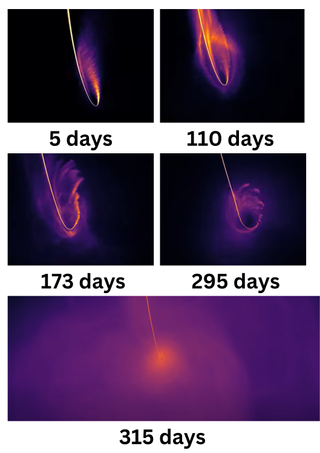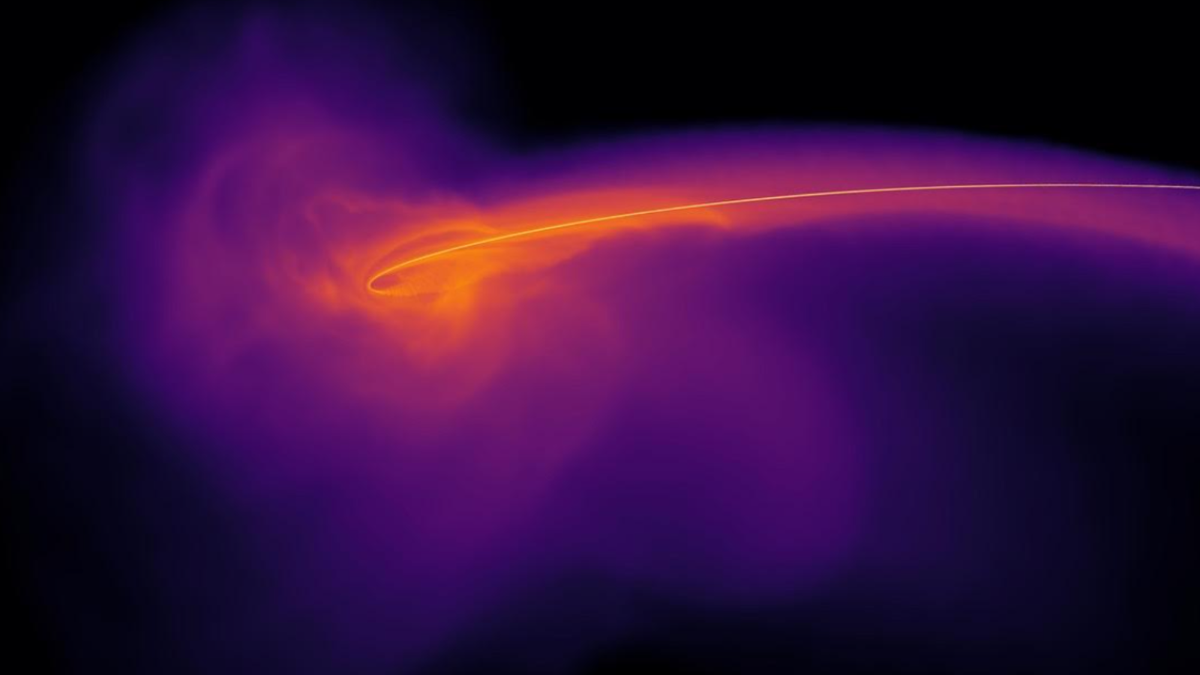“What happens when you throw a star at a black hole?” It’s not a question we can physically answer here on Earth.
Thankfully, actual black holes and stars can’t be smashed together in the lab! However, scientists can use advanced supercomputer modeling to simulate a black hole ripping apart and devouring a star in a so-called “tidal disruption event” or “TDE.” Doing just that, a team of researchers led by Danel Price from Monash University has discovered that the answer to our opening question is “things get messy.”
“Black holes are not able to eat all that much,” Price told Space.com. “So much like myself, after a bad curry, a lot doesn’t go down the black hole, and most of it comes back in the form of violent outflows. We observe this in tidal disruption events — strong outflows, relatively low and constant temperature material, and large emitting distances.”
If this isn’t stomach-churning enough, much like a Saturday night misadventure involving alcohol and a dodgy bhuna, black holes wake up surrounded by the regurgitated remains of their meals in a structure called an “Eddington envelope.”
“We found that during the disruption, the black hole gets smothered by material. This is new.” Price explained. “It’s an old idea that this should happen, but we were able to show how it happens by simulating the gas dynamics.”
Related: Massive star’s gory ‘death by black hole’ is the biggest and brightest event of its kind
Pasta and curry? No wonder black holes get sick!
TDEs occur when stars venture too close to the supermassive black holes that lurk at the heart of all large galaxies.
“Stars get bumped by each other as they travel through the galaxy, so their orbits get slightly perturbed. Just occasionally, once per 100,000 years, a star will get bumped enough to become bound to the black hole and plunge towards it,” Price explained. “The key is that stars only get bumped a little bit, so like comets plunging towards the sun, they tend to come in on parabolic orbits. These are challenging to simulate.”
Once the star is too close to the supermassive black hole, the immense gravitational influence of this cosmic titan generates powerful tidal forces with the star that cause it to be squeezed horizontally and stretched vertically.
This process, called “spaghettification” (we know we’ve switched cuisine here, but stick with it), turns the star into bright noodles of stellar material or “plasma.” This wraps around the destructive black hole like spaghetti around a fork. From this swirling flattened cloud of superheated plasma called an “accretion disk,” the supermassive is gradually fed.
The TDE process and the swirling disk of stellar debris around the black hole generate powerful electromagnetic emissions that allow astronomers to study these events.
Yet there are still mysteries surrounding TDEs that need to be answered.

To get into the intricacies of TDEs, Price and the team performed the first self-consistent simulation of a star being tidally disrupted by a supermassive black hole to track the evolution of the resulting debris over a whole year using an advanced smoothed particle hydrodynamics code called “Phantom.”
“Essentially, we threw a star at a black hole inside the computer,” Price said. “Specifically, we spent a long time trying to correctly implement the effects of Einstein’s general theory of relativity, which describes the spacetime near a black hole.
“Our simulations provide a new perspective on the final moments of stars in the vicinity of supermassive black holes.”
The Phantom simulation revealed that stellar debris created during a TDE forms an asymmetric bubble around the black hole. This leads to the reprocessing of the energy, producing light emissions with lower temperatures and fainter luminosities.
The team also discovered that this gas moves around the supermassive black hole at speeds of 22 million to 45 million miles (10,000–20,000 kilometers per second), which is about 60,000 times the speed of sound at sea level or around 7% the speed of light.
“The study helps to explain several puzzling properties of observed TDEs,” Price said. “A good analogy is the human body: when we eat lunch, our body temperature does not change much; this is because we reprocess the energy from lunch into infrared wavelengths.
“A TDE is similar; we mostly do not see the black hole stomach eating gas because it is smothered by material that reemits at optical wavelengths. Our simulations show how this smothering occurs.”
The reprocessing of energy and black hole smothering in the simulation explains one of the biggest observational mysteries about TDEs, understanding why they emit mainly in optical or visible wavelengths of light rather than X-rays, Price added.
The findings also explain lots of other TDE mysteries, including why star-shredding is seen in fainter light than expected and why this material appears to be moving toward us at a fraction of the speed of light.
As for the future, the team’s simulations have left a lot of food for thought.
“There are lots of things to explore here. Once the Vera Rubin Observatory starts operating, we expect thousands of observed transients in the next ten years,” Price concluded. “We need to try the same kind of simulation for all kinds of stars and different-mass black holes so it is applicable to different observed events.”
The team’s research is published in the Astrophysical Journal Letters.












/https://tf-cmsv2-smithsonianmag-media.s3.amazonaws.com/filer_public/34/31/3431771d-41e2-4f97-aed2-c5f1df5295da/gettyimages-1441066266_web.jpg)






Discussion about this post